Written by Terry Smith
Our site is reader supported so when you click a link to Amazon we may earn an affiliate commission.
UK’s best garden hoes: Dutch, draw, scuffle, and oscillating compared
This article was last updated on April 23rd, 2022 at 5:59 am
Ask any gardener worth his salt which tools they class as important and I guarantee that a garden hoe will be high on that list – much easier than a weeder, but lighter than a spade. Hoes have been used since ancient times to clear or shape soil in preparation for planting, to remove weeds, to harvest potatoes and other root foods, as well many other uses.The design is simple enough, a blade on the end of a shaft, but a wide range of different sized and shaped blades have been used over time and across the world, for various purposes including weeding or breaking up soil like a fork or spade.
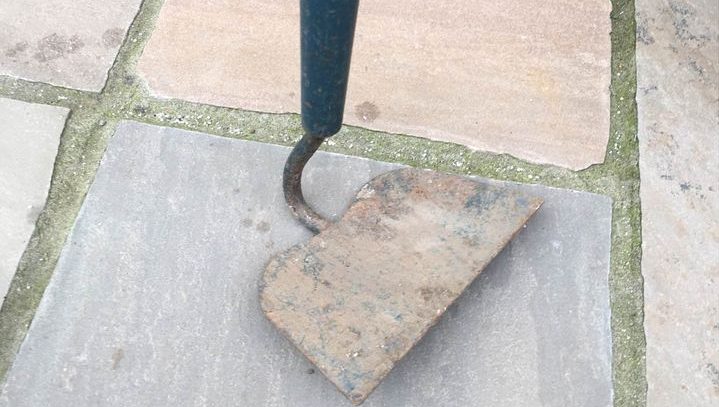
In terms of performance, the best garden hoes should be sturdy and have a comfortable handle to grip, the blade edge should help you cut through soil even if you aren’t the strongest, and it should be well priced so based on these ideas I have reviewed the best garden hoes to save you time.
Best hoes: editor picks:
Best overall garden hoe – Spear & Jackson Kew Gardens 3983KEW Stainless Steel Dutch Hoe
Best dutch hoe – Spear & Jackson 2135NS Select Carbon Steel Dutch Hoe
Best draw hoe – Stanley Fatmax Fiberglass Garden Hoe
Best scuffle pick – Fiskars QuikFit Push-Pull Weeder
Oscillating hoe pick- Fiskars Xact Push-Pull Weeder
Heavy duty garden pick – Lanyota 2 in 1 Gardening Hoe and Rake
Short handled pick – Spear & Jackson 5050OH – Traditional Onion Hoe
Budget pick – Draper 14308 Carbon Steel Dutch Hoe with Ash Handle
hoe buyers guide
There are quite simply too many styles of hoes to speak about and if I’m honest and went on about all the different sub genres of hoes, I would probably fall asleep telling you. But there are three main types of hoes worth knowing about as knowing how they work then means you know how to choose the right tool for the job. It can be quite fun teasing the labourer and watching him struggle with the wrong hoe from time to time though too.
Types of hoe
Ok, so basically we have a hoe for pushing, pulling and digging. A push hoe or a dutch hoe as it is sometimes called is a very common hoe. It’s likely that this is one you have used before without even knowing it. It is really comfortable to use and the blade is laid just below the surface of the soil and then moved over the weeds. The blades aren’t huge so it’s good for getting small weeds in the flower beds between what’s growing:
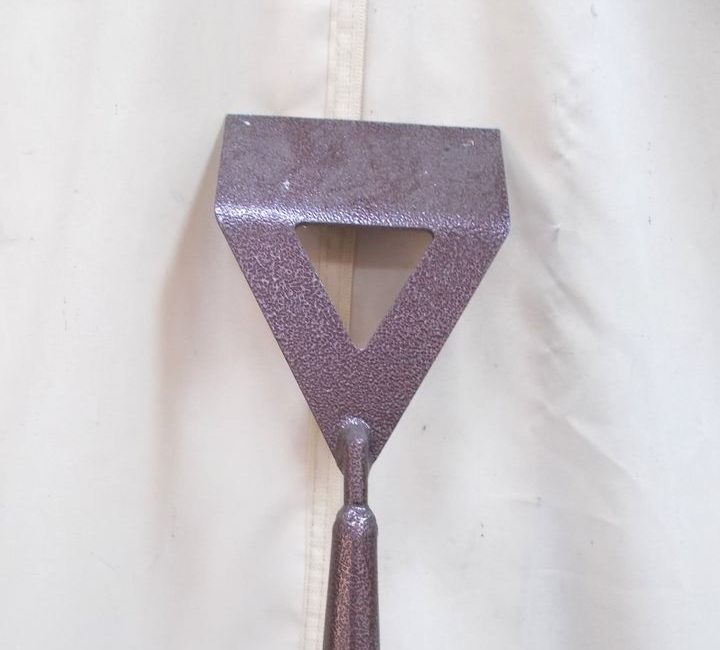
A draw hoe, literally given its name because draw means “to pull”. It’s used to shape the soil and it’s good for either hard or soft soil. The handle meets the blade at a 90 degree angle and it is used in a chopping or digging motion and pulled towards you. There are a few different types of draw hoe. Some are more heavy duty than others and some are designed to tackle small weeds or great big tree roots:
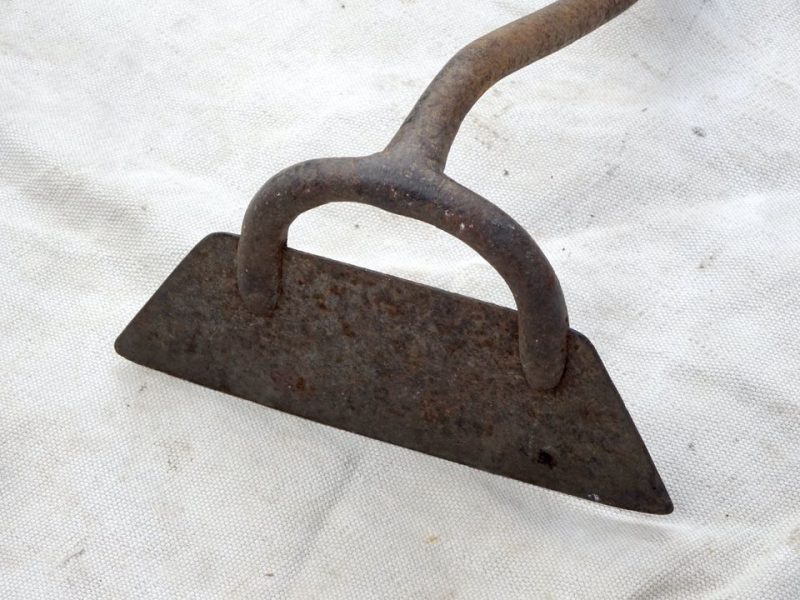
Formerly the stirrup hoe with some improvements and now called an oscillating hoe or action hoe is designed to cut on both the forward and the back strokes as the blade is attached to the end of the handle on a pivot. The pulling motion also helps with the larger weeds, when it is pulled the blades move deeper into the soil smashing through the roots. There’s something quite enjoyable about using this style of hoe once you find your rhythm.
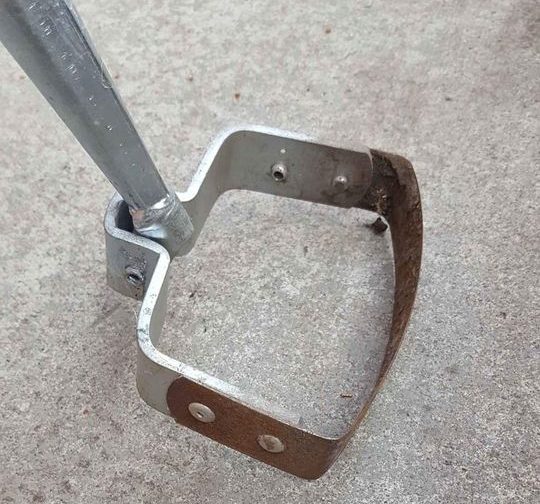
How to decide which garden hoe is best for the job?
There’s no way on earth you are going to get a 100 percent definitive answer for such a question. Larger jobs require different tools however smaller trickier jobs that take forever might require something completely different all together. That being said, I always have my preferred equipment ready and sometimes use what is going to make my life a little bit easier rather than save time. I can only guide you to making a choice and finding your own preference on this one. Sometimes it just comes down to what we like and what we don’t like. this old boy knows his stuff – bear with him, he’s very knowledgeable:
A few basic tips though, I am not a fan of breaking my back and hunching over all day so I am going to opt for a long handled piece of equipment. Secondly if I am only going to tackle small to medium sized weeds and not tree roots then I’m not going to jump round the site with heavy duty draw hoe. It doesn’t make sense to make my life harder than it needs to be. As I said before I have a preference at the end of the day and if I am weeding large or small areas I’ll still opt for an oscillating hoe. I just feel the push and pull motion makes my life that little bit easier and it means I get to go home quicker too! But I don’t mind putting in a little effort now and then. That being said it’s no match for any decent sized root so I will need that previously mentioned heavy duty draw hoe to hand. So, of course weigh up the job before blindly walking round the tool shed, remember work smarter, not harder.
Handle material
There are a few different choices when it comes to the shaft of a garden hoe.
Firstly there is wood or ash wood and hardwood are the most common. The hardwood classic is hard wearing and heavy duty and it’s decent at cushioning the blows if you have a tough annoying tree root or just a fair amount of digging. Obviously the biggest drawback of wood is it being vulnerable to weathering over time, albeit a long time unless it’s not taken care of and stored correctly, you are going to find it begin to rot. That being said, the handle is replaceable, and it’s not going to break the bank either.
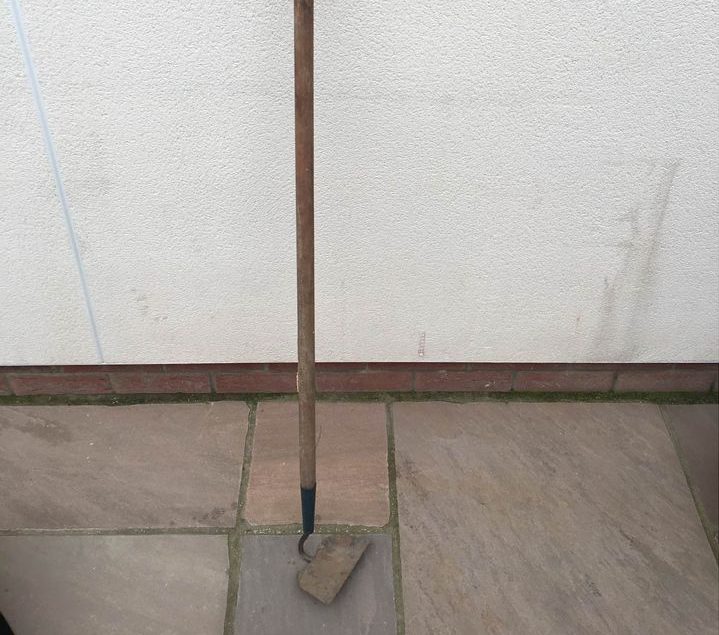
If it’s durability you are after then you can go for the steel option. Although you are sacrificing one trait for another. Steel is going to last longer but it is most certainly not good at taking the brunt of the shock as it makes contact with different surfaces. Plus it’s heavy, which means it will take its toll on your shoulders and arms after a full day’s graft.
Ok so, Aluminium is somewhere in between. It is a lightweight option and it’s also going to withstand the wear caused by British weather, it’s definitely not going to start rotting on you if you’ve left it outside for a few weeks. Again, we are in a trade off for durability as the aluminum handles aren’t great at shock absorption either.
So where do we go from here? It feels like we are having to substitute a robust handle for something that will help take the hits for our bodies, or visa versa. Fibreglass is an option that will give us that shock absorption, taking care of the labour side of things. Plus it is also lightweight, yet robust and it’s definitely not going to decay like wood. Meaning it can be stored anywhere. One thing to consider is that they are a bit of a pain to replace, but do check with the manufacturers to see what sort of warranty they have, you might be pleasantly surprised.
As we are speaking about the handles do take into consideration what the job entails. Handle length is going to be important as we dont want to put constant strain on the back. Especially when it can be avoided by buying the correct length to start with. My advice here is pick the thing up and actually hold the tool in your hands and you can normally gauge if you’re bent over too much, off balance and if you’re going to need a longer or indeed a short style of garden hoe.
Lastly, in my eyes the light weight options are always going to be better, as long as you’re not going to Fisher Price to buy your tools you should be ok. Heavyweight tools are needed of course but we assess the workload and use them accordingly.
Which material is best for the blade?
Almost all the blades used for garden hoes are going to be a type of steel of some sorts. There are different types of treated steel, the most common two types are carbon steel and stainless steel. You will find that the carbon steel will possibly rust a bit quicker if it’s not taken care of but it’s definitely more robust and hard wearing that stainless steel.
That being said, unless you are really putting the stainless steel through its paces it’s hard to notice and stainless steel is easier to sharpen than the carbon. If you see that the steel has been heat treated then it’s going to be very robust and tough. Likewise if the blade has an epoxy coating or a powder coating it’s going to be more resilient to rusting.
What sort of price am I looking at?
The price range is going to vary from style to style, size and the quality of the tool too. Hand held tools are normally less expensive than the longer shaft, larger tools too. So, choosing the right tool for the right job is going to save you money. You are really looking at a huge range when it comes to garden hoes anything from under £10 to just over £30 again it’s a hard one to call with so many factors to think about.
What is required to maintain a garden hoe?
It pretty much goes without saying that if you look after your tools you will get much longer use out of them. And personally it really gets my goat whenI even see people not taking care of their tools. If you pay good money for something then it’s definitely worth taking a little extra care with it. Not just storing it in a dry place away from the elements (which is pretty obvious stuff) but sharpening the blade too. I have always found that when any tool is working to its full capability then I’m not going to be compensating for its inability to get the job done correctly. If I have a blunt blade I’m going to be using brute force instead of letting the tool do the work. Not only is that detrimental to my health as my form when using the tool won’t be correct but it’s also going to take its toll on the blades, handles and grips too.
It just makes more sense to me to regularly check all the tools and see what needs some tender loving care every now and then, just like my misses really. We want the blade to do the work and effortlessly cut through the soil, weeds or roots. Before sharpening the blade, give it a quick once over with soapy water and clean off any dirt then dry it off. You can then use a sharpening stone, (oiled works best) to get the blade up to the job again. Making your life easier in the long run is the idea, if you go for the hardwood handles, why not grab some sand paper and possibly give them a once over too.
1. Spear & Jackson Kew Gardens 3983KEW Stainless Steel Dutch Hoe
Made from sustainable materials including FSC certified weatherproofed ash wood. This dutch hoe has been developed by Spear and Jackson with the help of the guys from the Kew Gardens horticultural team and in my mind the best overall garden hoe. It has been fully licensed and officially endorsed as part of the Kew Gardens collection. The ash wood handle is extra long at 60 inches which I favour as I’m not a tall guy (5ft 9) but the other lads are and after 20 years plus of landscape gardening anything that helps combat the back strain I am always going to favour.
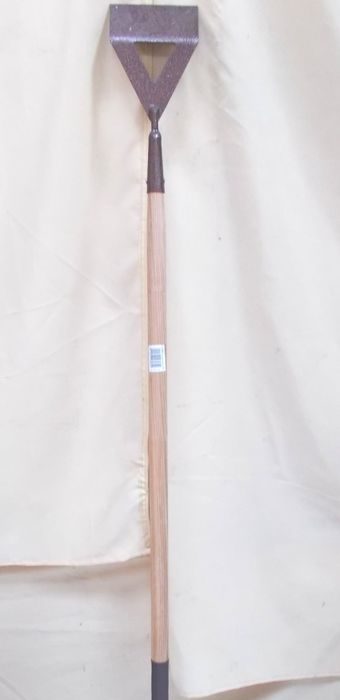
Spear and Jackson have treated the ash wood to combat the weathering and the knocks that come with using, storing and transporting of tools. There is no grip as the ash wood is relatively comfortable and you can use it without gloves for extended periods of time, mainly as we aren’t digging with a dutch hoe so there’s no real need. It does come with a handy leather loop for hanging while in storage. The blade cuts great, I found it effortlessly glides through looser soil and can break up the compacted soil pretty well. It cuts the weeds on both the push and the pull nicely as a result of the angle on this Dutch hoe – it grabs nice on the return pull.
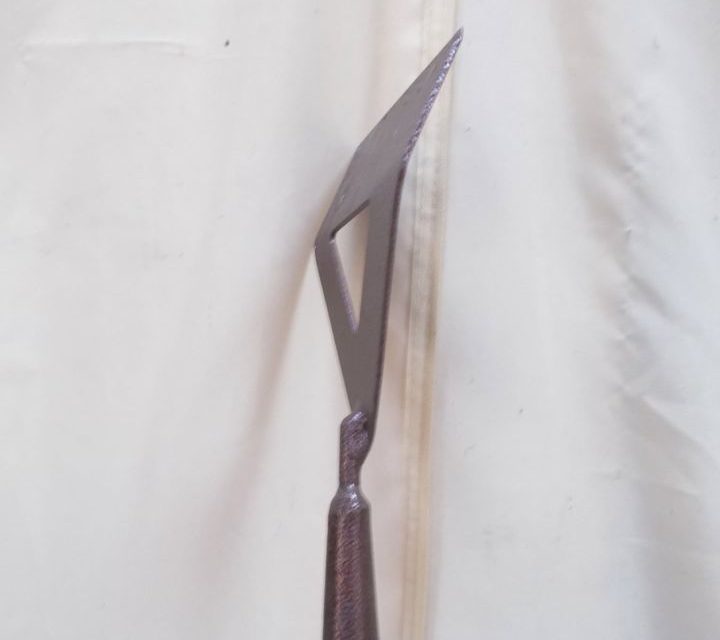
Made from mirror polished stainless steel it’s the twin edges that really give it that effortless cut. The blade is rust proof and easy to clean so you will find that the soil won’t stick to the blade either.
Pros
- Made from environmentally friendly material
- FSC certified durable treated ash wood
- Extra long 60 inch handle
- Leather storage loop
- Mirror polished stainless steel blade with twin edges
- Rust resistant and easy cleaned blade
Cons
- No grip on the handle might put some people off
2. Spear & Jackson 2135NS Select Carbon Steel Dutch Hoe
This Spear and Jackson dutch hoe was a strong contender for overall hoe, it was hard to choose between the Spear & Jackson Kew Gardens 3983KEW Stainless Steel Dutch Hoe so it made sense to see this excellent dutch hoe claim best budget pick instead.
The blade has been heat treated, made from durable carbon steel with two chamfered edges for cleaner cuts. Another addition to the blade is the improved resistance to the alkalis in the soil, the rust and the general wear and tear from usage. This comes from the coating of epoxy that Spear and Jackson have applied as standard. While we normally suggest fibreglass or hardwood this tubular steel handle, while on the heavy side does a great job coupled with the soft grip handles at gliding through the soil cutting out any unwanted weeds. The soft grip also allowed me to use it continually without the need for gloves.
Pros
- Great price for such a quality hoe from a quality brand
- Carbon steel blade with chamfered edges
- Epoxy coated blade that is resistant to the alkaline in the soil, rust and wear and tear
- Durable steel handles
- Soft grips
Cons
- The steel tubular handle is a bit heavy
3. STANLEY FATMAX Fiberglass Garden Hoe
The Stanley Fatmax brand is well known for bringing professionals and DIY builders and landscape gardeners rugged, no nonsense tools. This fibreglass garden hoe is no different. The blade is made of heat treated steel taking care of tasks like digging and shaping soil as well as taking on large weed roots and small tree roots – you can keep it as sharp as you like because the heat treat is bang on – and I think it justifies being the best draw hoe if I’m honest. The handle is made of fibreglass and has been reinforced with steel. The fibreglass is lightweight but the reinforcement by the steel makes this heavier than most but it’s a robust piece of equipment to say the least. It’s also a decent length, at 58 inches it comfortable enough on your back – even for the tallest.
A quality draw hoe is going to give out a fair amount of vibration because of the way in which it’s used compared to the dutch hoe and you are going to feel that at the end of a long day. However, we can see that Stanley has decided to address this issue with a number of positive design features. First off, the use of a vibration reduction collar has decreased the amount of shock absorption. They have also used what they call a “control grip”. A soft grip handle that adds to control with its non-slip qualities and I’m sure it probably helps with the shock absorption a little too. Providing a more efficient draw hoe for big or small jobs.
Pros
- Sturdy and tough design
- Long lasting fibreglass and robust steel reinforcement
- 58 inches in length
- Handles vibration with a vibration reduction collar
- Non-slip control grip
Cons
- The reinforced steel makes it a bit on the heavy side
4. Fiskars QuikFit Push-Pull Weeder
Friskers have created a range of tools they call QuickFit and it’s just as good as the Fiskars Xact garden puller – they are really zooming in on how to handles weeds in the last few years. The idea is that it saves you time, money and storage. You do need to buy a handle which fits all tool heads – you’ve got the shorter Fiskars QuikFit Handle and the longer Fiskars QuickFit Shaft L – giving you easy access to draw, pull etc at sensible money. Ranging from a lawn edger, a patio knife to other styles of hoes. One style being a decent scuffle hoe. We are focussing on a scuffle here and this one deserves a spot as top pick though here. Going back to the handle, or handles should I say. There are 4 to choose from. We have supplied links to the small 24cm Quickfit handle for those who prefer to use the device as a handheld tool and to the 156cm QuickFit Shaft L for those who fancy a bit more length and less strain on their knees or backs.
The durable aluminium with non-slip soft handle grip does make a difference – you have more control. There is also a hole in at the end of the shaft for hanging storage. The idea here is that any head from the QuickFit range can attach to any handle from the QuickFit range with a simple automatic locking system. I found the slide and pull system sensible enough to use and easy to attach and detach. Now, let’s hear about the scuffle hoe itself. Again let’s quickly praise the QuickFit connection system which feels durable when connected. The blade is made from robust steel and is 15.5cm in width so a nice size for weed removal in flower beds. The tough blade can tackle soft or stoney soil well and the back and forth motion makes it less strain on the body when you’re going at it for longer periods of time. Both the Fiskars QuickFit Shaft L and the Fiskars QuikFit Push-Pull Weeder are still light even with their weights combined. Obviously it’s even lighter when used with the Fiskars QuikFit Handle, which is the short handled option. It is a great Idea and if you have the money you could buy all the handles and all the tool heads, although it does start getting costly when you try to buy everything. But if you’re like me sometimes I just can’t help but buy everything – tool hoarder disclaimer 😀
Pros
- Attachable heads save time and storage with lots of other tools in the QuickFit range
- Handles come in various sizes made from lightweight aluminium
- Handles and tool heads have non-slip grips with a simple pull and slide automatic locking system
- The tool head blade is made from durable steel and is an optimum 15.5cm width
Cons
- Buying tool heads and shafts of different sizes can be annoying and costly
5. Fiskars Xact Push-Pull Weeder
This oscillating hoe by Fiskars is designed to make light work of weed roots without harming plants and flowers – I’d say of all the oscillating hoes this is the one that delivers on that. The handle is made from a robust aluminum, it’s lightweight but doesn’t sacrifice durability. The soft grip is extra long which I really liked as I am still able to hold onto the grip and use it in many different positions. There’s a hanging hoop at the top of the handle too for storage. The full length is 167.5cm so it’s really built for turning a chore into something more bearable and far less of a workout. The real bonus here is the movement of the head.
The double edged stainless steel blade allows excellent cutting on both the push and the pull movements. There are specially designed teeth to aid the pull motion when cutting to make it easier to cut through the soil and make cuts. The blade has a width of only 13.5cm which to be quite frank could have been slightly wider, especially when the Fiskars QuikFit Push-Pull Weeder has an extra 2cm on it. It’s not the end of the world but it just would have made more sense to me to make it the same size. Nevertheless, I really like this tool because it makes it very easy to use for extended periods of time and does exactly what it’s designed to do.
Pros
- Durable aluminium handle
- Extra long soft ergonomic handle
- Storage loop on the handle
Cons
- The blade width could be slightly bigger… but only slightly
6. LANYOTA Gardening Rakes Shovel,Digging Hoe Garden
The small but mighty, made from lightweight heat treated steel is pretty heavy duty – chopping through roots like a karate expert chops through planks of wood! Ok, it’s not gonna get you through planks of wood but it tackles reasonable sized tree roots which gives you an idea of how robust and powerful this tool really is. It doesn’t just smash through tree roots like they are nothing but it can dig and loosen soil. Plus also capable of more graceful tasks like weeding throughout smaller flower beds. You can give it some wheelie and it does the tasks with ease at only 38.5cm in length with a hanging hole at the end for easy storage . We could have seen this take the best short handed hoe spot too. The shorter and smaller design helps add to the thrust and power in a chopping motion. Not only do you get all that short handed draw hoe heavy duty action, Lonyota have also added a handy two in one feature by giving you a rake as well. Simply spin the tool round and away you go, need to look for your rake if this one will suffice. To top it all off it’s a decent price too we really couldn’t knock it.
Pros
- Lightweight heat treated steel
- Designed for heavy duty tasks at high intensity
- Short ergonomic handle held design with a length of 38.5cm
- Two in one feature draw hoe and rake
- Excellent value for money
Cons
- You couldn’t use this all day on your knees, some jobs might require a long handled hoe
7. Spear & Jackson 5050OH - Traditional Onion Hoe
I love the traditional rustic design that Spear and Jackson went for with this short handled hoe. By short we mean 32.5cm in length. The hardwood handle which is weatherproofed for extra protection and durability has a leather wrist strap which we just used to hang it up. I know I get annoyed from time to time but I’m not going to start chucking my tools at people. Although we did like the way it is in keeping with the traditional and rustic look. The ergonomic handle feels decent too, almost like it’s moulded to your hand. You aren’t going to be doing any forceful chopping with this hoe but it feels sturdy and the stainless steel has been mirror polished, the blade is sharp and cuts through the soil and digs nicely. The mirror polished steel ensures minimal soil adhesion and resistance to rust.
Pros
- Traditional and rustic design
- Short length 32.5cm
- Weatherproofed hardwood ergonomic handle with leather wrist strap
- Mirror polished blade
- Minimal soil adhesion
- Rust proof
Cons
- If you start using this for anything other than low intensity work it will break on you, but we trust you will use the right tools for the right job.
9. Draper 14308 Carbon Steel Dutch Hoe with Ash Handle
Draper are a good quality brand that no doubt you have heard of – they are always delivering mid range tool quality at the lower end of the pricing structure – it applies to almost all hand tools too. And it’s unsurprising
You get a whole lot of hoe for this price 😀 I’m talking the soil breaking, weeder incase your mind wandered then 🙂 Firstly, the price here is inexpensive even though the price is actually subjective to what you want to use the hoe for and as there are so many different styles of hoe I wanted to choose a decent option for the most common style of hoe.
Draper has gone with a lovely classic look and opted for the ash wood handle which is lightweight. The handle has been treated with a clear lacquer for extra protection against decay from the weather. The handle length is 151cm which is not the longest but I was able to use it so it will suffice the taller users. The blade is a 120mm width carbon pressed steel and has been coated with a rust resistant epoxy. This is a great budget option but personally if you have just an extra few quid I would go for one of the Spear and Jackson models mainly as the blades seem more heavy duty and longer lasting as the blade here could be sharper.
Pros
- Inexpensive
- Lightweight
- Ash wood 151cm length handle treated with a clear lacquer
- 120mm carbon steel, epoxy coated blade
Cons
- Blades could be sharper
- For a little extra money you can buy a better garden hoe
Final take home
Just in case you missed it in the buyers guide, I would say the most important thing to consider when buying a garden hoe is buying the right hoe for the job. I hope that after reading this guide we have helped you decide which tool is best suited for your needs and you can agree that it’s definitely better to work smarter and not harder.























